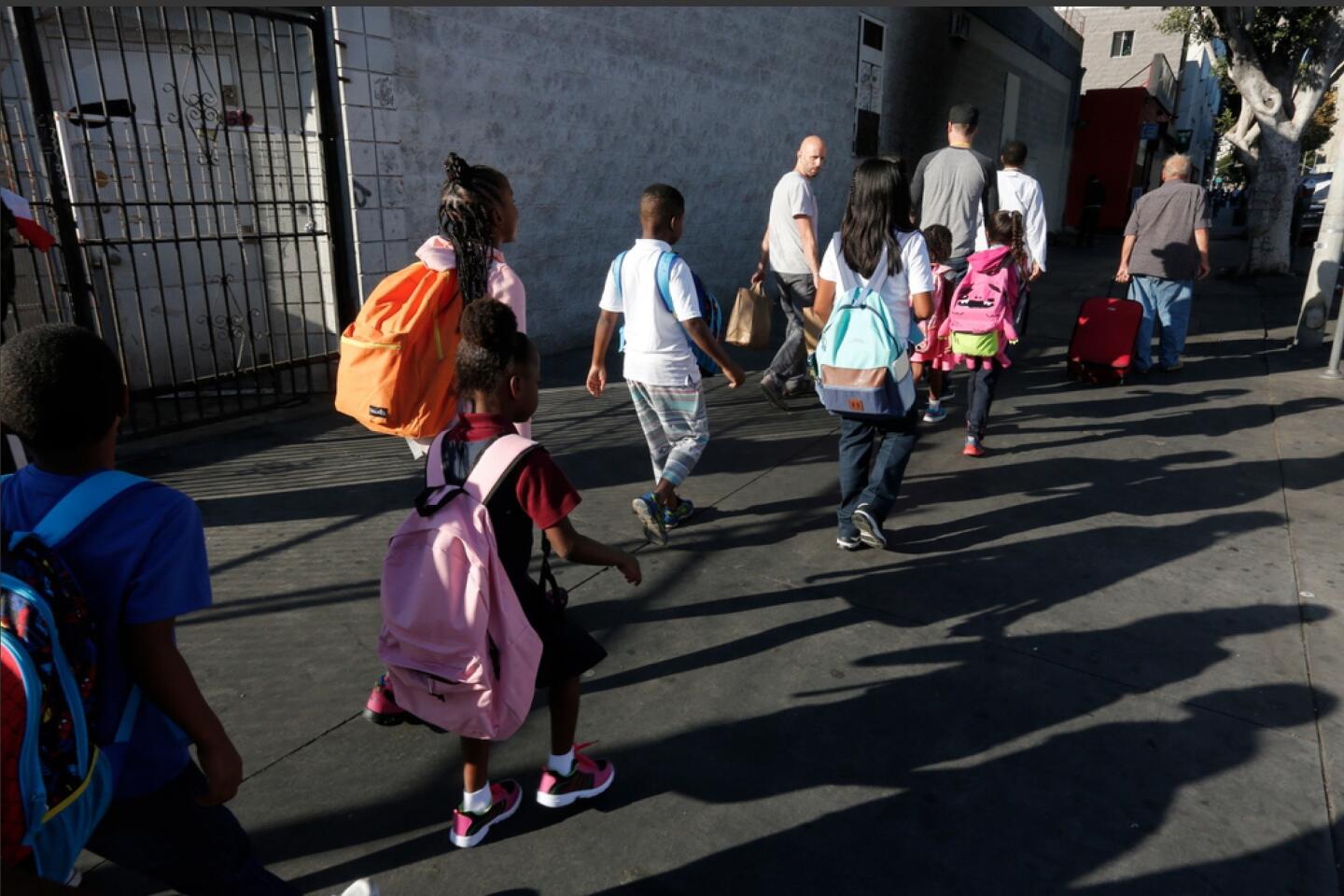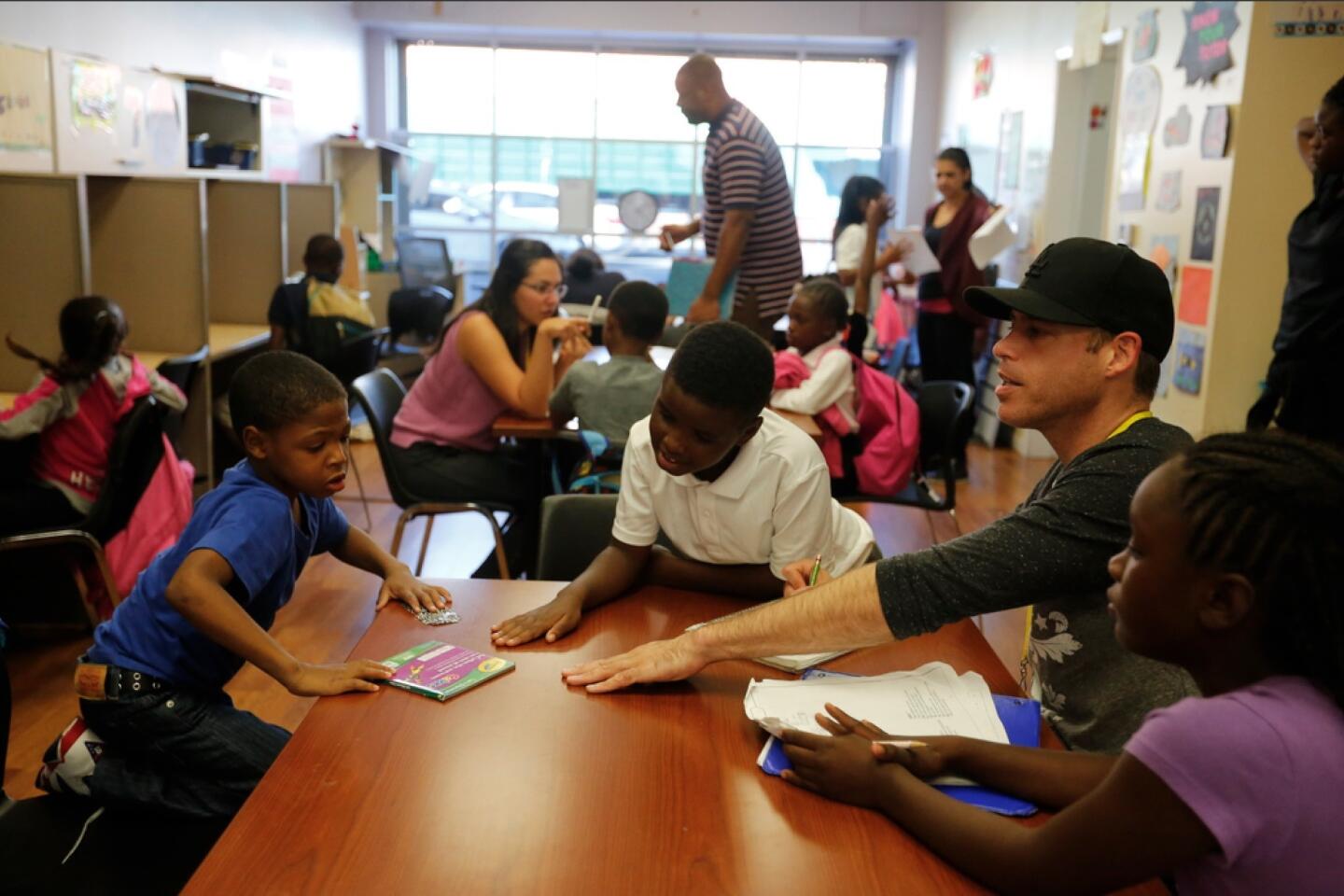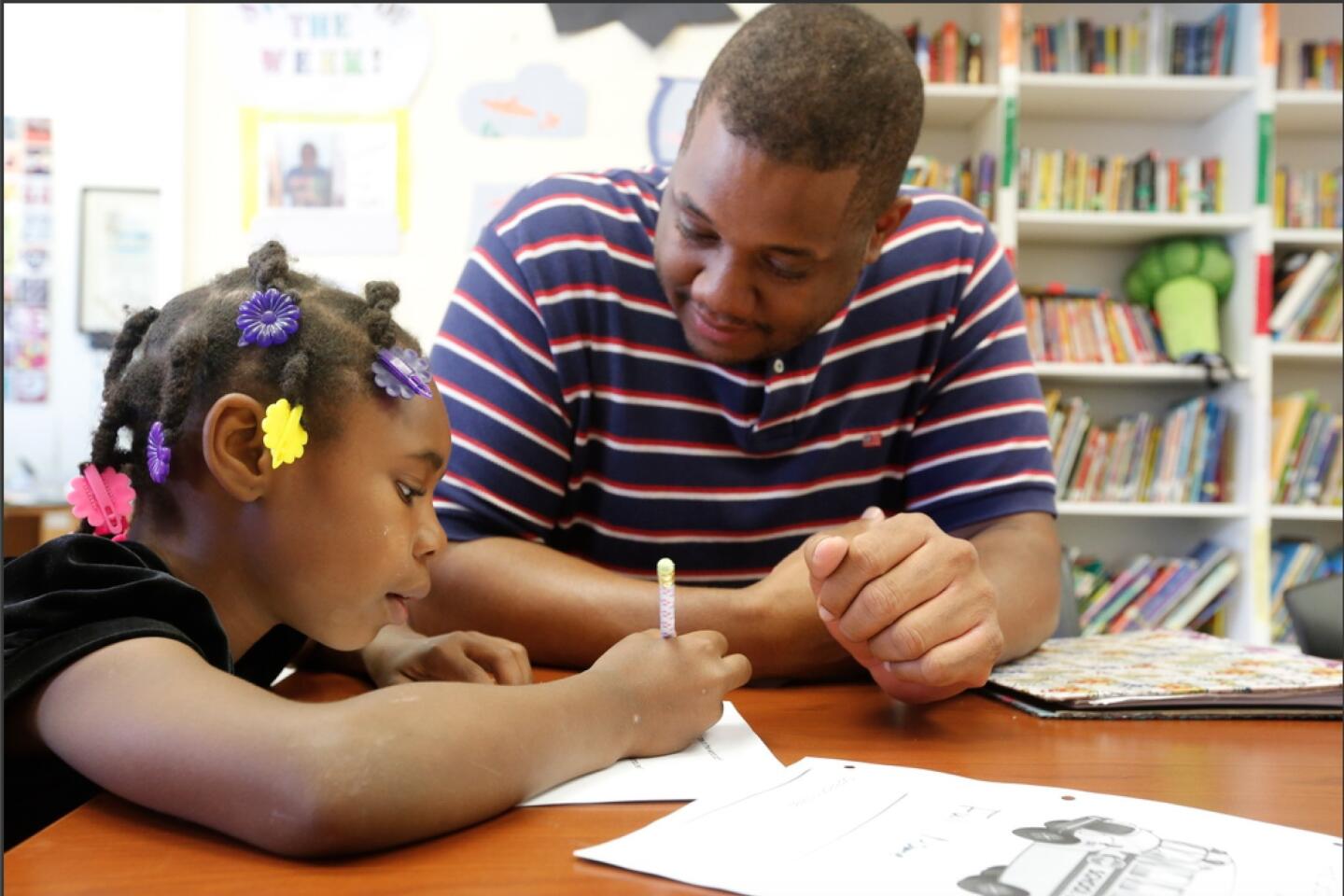There are 63,000 homeless youths in L.A. County. These are the children of skid row

The School on Wheels program aims to help kids living in a homeless situation by providing tutoring and counseling to keep them focused on education.
- Share via
Their eyes shift from joy to fatigue as they walk hand in hand and take in the tents, the smells, the people.
The smaller ones tune it out, faces blank. The eldest openly stare.
These are the children of skid row — black, white, Latino. They have pink and red Adidas sneakers or thumbs in their mouths or studs that glint like diamonds in their ears or the first hint of hair above their lips. They’re sisters and friends who profess their love for each other, who like listening to music when they study, who talk in class without raising their hands.
They could be any kids.
Most wake up in the Union Rescue Mission shelter, go to school, and then get tutoring help at the School on Wheels Skid Row Learning Center looking out on Seventh and San Pedro streets. Street dwellers check their reflections in the mirrored glass that shields the children from view.
Twice a week, after tutoring, to play in the Union Rescue Mission’s gym, the children need to travel one and a half blocks from the School on Wheels. Led by the tutors, they walk holding hands, two by two, parting life on the San Pedro Street sidewalk.
Sometimes, fights stop. Sometimes, people put their drugs away or tell the children to stay in school.
This is no place for you, they say without saying.
The number of homeless young people — students in schools and their siblings— seems to be growing. In 2014-2015, the Los Angeles County Office of Education estimated them at almost 55,000. The preliminary count for last school year was 62,931. L.A. Unified, as of October, had identified 14,500, meaning about one in 45 students in the nation’s second largest school district does not have stable housing.
Some live in motels or doubled up with relatives or in shelters scattered across the county.
Living on skid row is different.
On the short stretch between after-school and the shelter, the children often see things unfit for young eyes. So it was in these moments taken from five walks this fall.
Some of the children are mentioned by first name only, out of families’ concern that they might be bullied in school if their classmates knew they were homeless.
::
“Everyone partner up!” hollers Allison Maldonado, the head instructor at School on Wheels. She wears a gray T-shirt and jeans, her dark hair cut in a sharp bob, the bottom half shaved to ward off lice. The School on Wheels requires that she regularly get shots to guard herself against tuberculosis. On skid row, she wears boots or sneakers and makes sure never to lean against walls or poles.
One pair at a time, the students line up outside the learning center, along Green Apple Market on Seventh. As a volunteer hands each of them a cheese stick, a wiry man in an undershirt kneels against the wall of the learning center, unmissable but not blocking their way. The students snake around him.
On the sidewalk, there is trash but the kids do not add to it. Ke’Juan, a 13-year-old with curly hair and piercing blue-green eyes, walks down the line, holding a brown paper bag to collect the cheese-stick wrappers.
::
The kids begin to move past a group of three tents in which people live. They smell pot. They also smell urine. Sometimes, they’ll warn each other not to step in the puddles.
Stephone is six and small. He’s wearing yellow, carrying a Spider-Man knapsack. At Seventh and San Pedro, a man hits him playfully on the head. “What you doing?” Stephone asks.
The man does it again. Stephone calls out, “He just hit me on my head!”
He’s had a rough afternoon. He asked a girl to prom, only to be rebuffed and learn that prom is for bigger kids. He bunches up his backpack straps in his hands.
Even though it’s a hot day, they pass a man in a red sweater. He leans against a door, digging into the camouflage back he sits in, his legs covered by ragged pants.
Shakira munches on cheddar cheese Goldfish crackers while she walks. The tall 12-year-old, hair in cornrows, came from Mississippi originally. She sleeps in her shelter bed with three teddy bears, and wants to be a doctor. On the shelter’s roof, she once watched a man run dirty water through filters. That was new to her, as was what came next: When she asked for a sip, he tried to charge her.
They pass a pile: a lone tent, a bent black bike, a woman folded into a shopping cart, swaddled in blue tarp.
When Maldonado can’t get students to focus or behave, she takes them outside and points. Is this the future you want for yourself, she asks? Your parents wouldn’t want you to be homeless.
Mid-block between Seventh and Sixth streets, the young people start to chant. “Kids coming through! Kids, kids coming through!”
“Louder!” calls Maldonado. And so they shout.
“So people can stop if they’re doing bad things,” says 9-year-old Kamylah Mayfield. Like that man running with a knife one day, who made Shakira and her mother run and hide.
Kamylah walks with her sister, Kelyese. They’re glad to be out of the shelter and in transitional housing, Kelyese says, because at the shelter they “make you hurry up and ... shut the light early.”
Kelyese is learning about the Neolithic Revolution in school, but she’s a little lost. Instead of paying attention in class, she’s been reading a book, “Bad Kitty.”
They pass a woman picking up soda cans and smashing them loudly against the cement before dropping them into a garbage bag, one by one.
Jordan Dibert, 17, brings up the rear of the line, in baggy shorts and a Dodgers cap. He’s the program’s oldest student and has wisps of hair on his cheeks. He holds a skateboard as he helps the younger ones stay in line. After his stepdad died, his family got evicted. Now it’s just him and his mom at the shelter.
He’s been talking to a friend in Barstow about finding a home. His situation, he says, is “just a bump in the road.”
A 7-year-old in a puffy black “church dress,” with flower clips in her braided hair, clings to one of the School on Wheels tutors and skips over gum and tissues. Kamilah speaks eloquently, but doubts her abilities. Just minutes earlier, she had told a tutor that she couldn’t read. Then she did.
Back in Las Vegas, she had a big pink room, she said, “because I’m a daddy’s girl and a princess.” Since August, she has lived in a room at the shelter with three sets of bunk beds — each one housing a different family.
On the east corner of Sixth Street, a bearded man sits on a bucket. He looks at the kids wistfully while squinting toward the sun. A hunched, emaciated woman talks to him. As the group passes, she stops, her mouth closed so tightly it could be sewn shut. A few steps on, they pass a man sleeping on flattened cardboard boxes and leaves.
Across San Pedro is another row of tents -- six of them, lining a parking lot. Outside one of them, a man in the process of stripping down sees the children and puts his shirt back on. Ke’Juan angles his head down and coughs into his shirt, and Shakira sips from her pink water bottle.
Some tents sell things, like candy, but Shakira says she knows to avoid it: “I don’t buy nothing because I’m scared they’ll poison it,” she says.
Before they cross Sixth Street, a man pumps his arms and bellows, “Kid power!”
To cross the street, the kids step around a woman with a shopping cart, who has been standing still in the middle of the crosswalk as cars pass. On the other side of Sixth, people sit in a row of chairs, some playing chess. The shelter comes into view. Three women sit and sway around a boombox. Someone says, “The kids are coming.”
The pavement outside the shelter has its own kind of bustle and thrum. “Go to school, get straight A’s,” says a woman in a UCLA cap, as she walks out and away from the building. “You have to study and get A’s. Well, B’s are OK.”
An elderly woman in a blue and green dress hunches as she struggles to push a cart filled to the brim. A stuffed panda bear threatens to fall out. Against the shelter’s blue-tiled wall, a woman sits wiping her eyes with one hand. The other stays hidden inside a brown Ralph’s bag. Her face sweats, its expression flat.
A tiny girl tries to run ahead into the shelter, but Jordan holds her back.
Maldonado opens the door.
::
Moments later, as soon as they climb two flights upstairs, they’re free to be kids again: running around a gym, kicking balls, shooting baskets, practicing cartwheels, hiding and seeking behind soccer nets.
They’re home.
At least, at their home for now.
To read the article in Spanish, click here
You can reach Joy Resmovits on Twitter @Joy_Resmovits and by email at Joy.Resmovits@LATimes.com.
ALSO
L.A. tops the nation in chronically homeless people, federal report finds
Enforcement questions add frustration to fear for neighbors of crime-plagued Talbert Regional Park
More to Read
Sign up for Essential California
The most important California stories and recommendations in your inbox every morning.
You may occasionally receive promotional content from the Los Angeles Times.


















